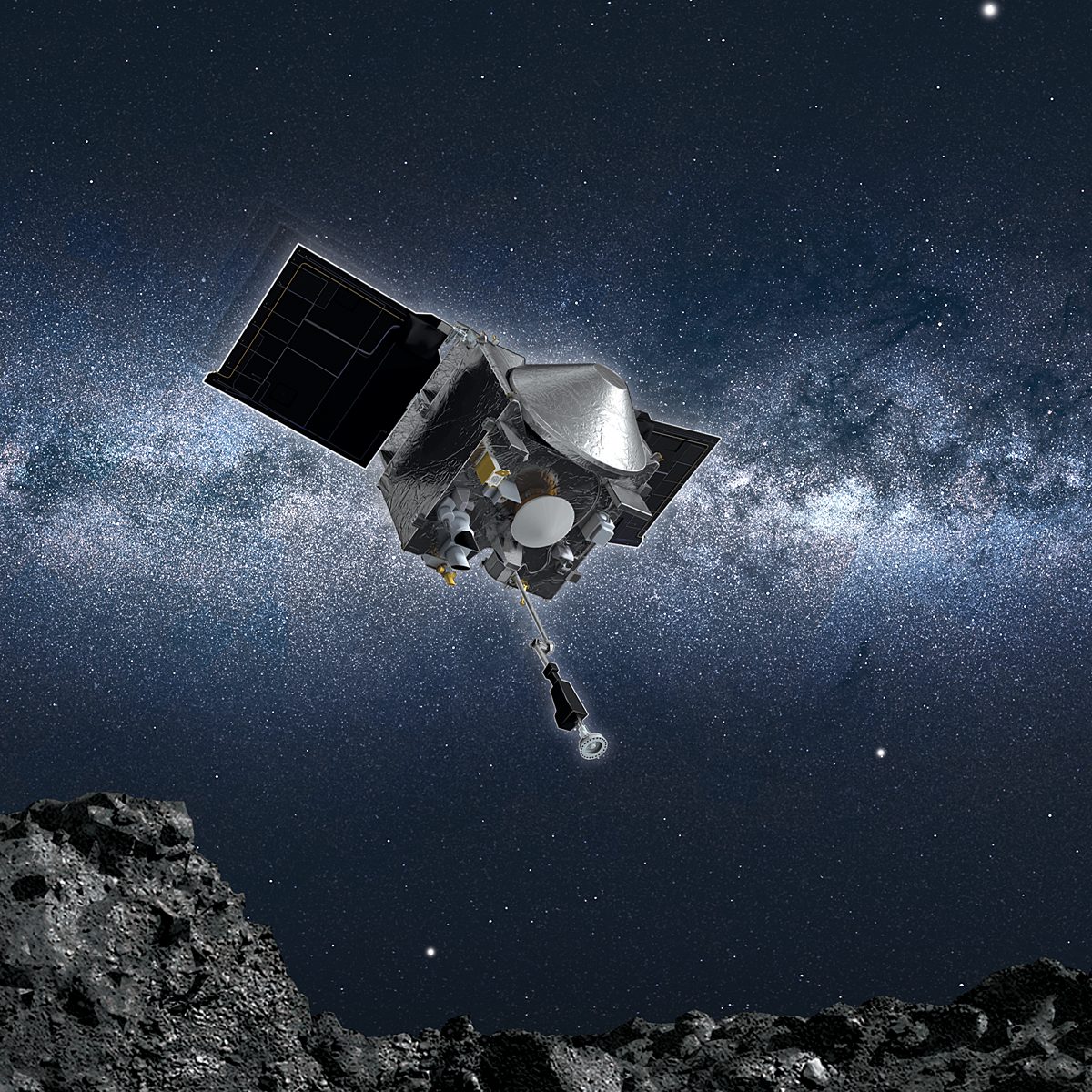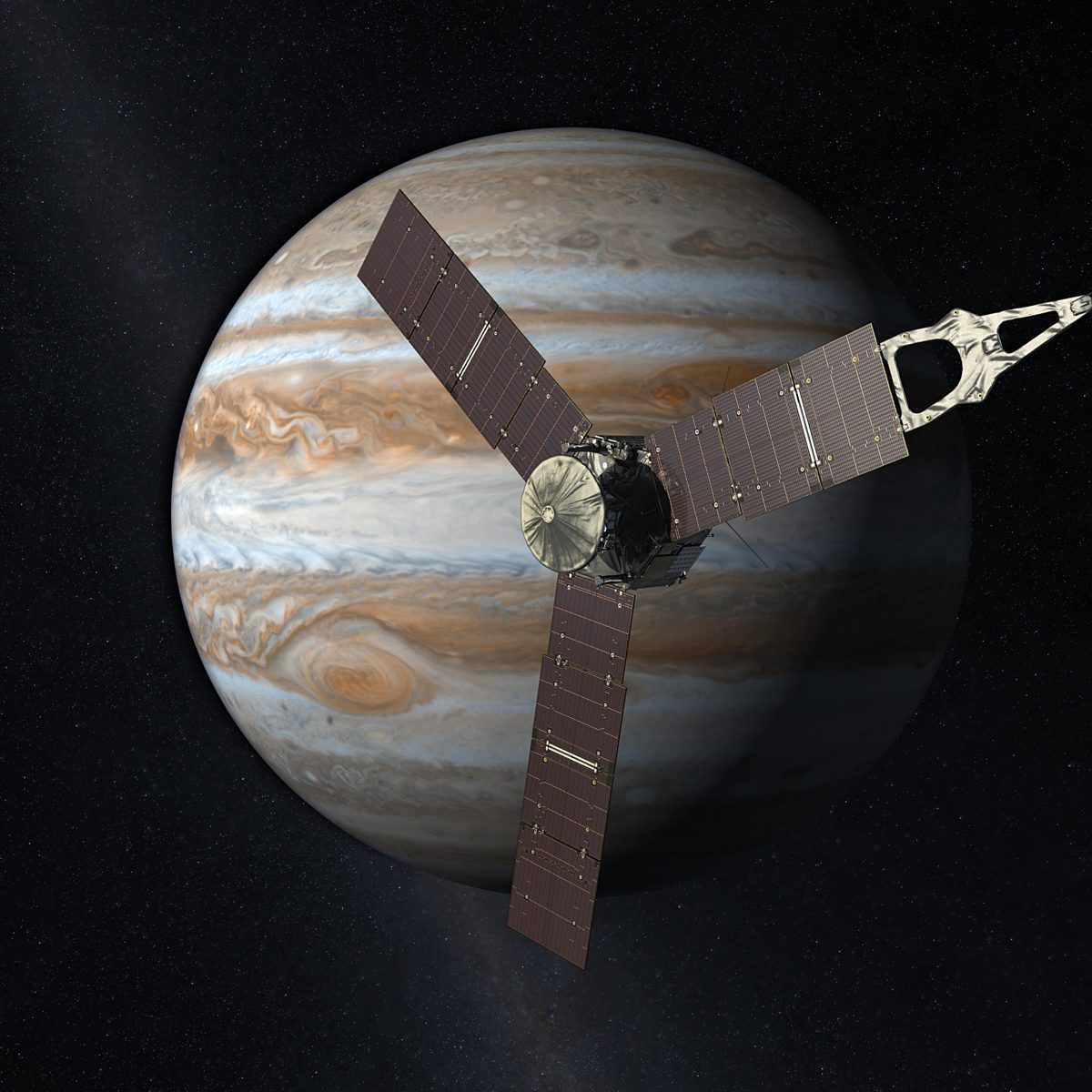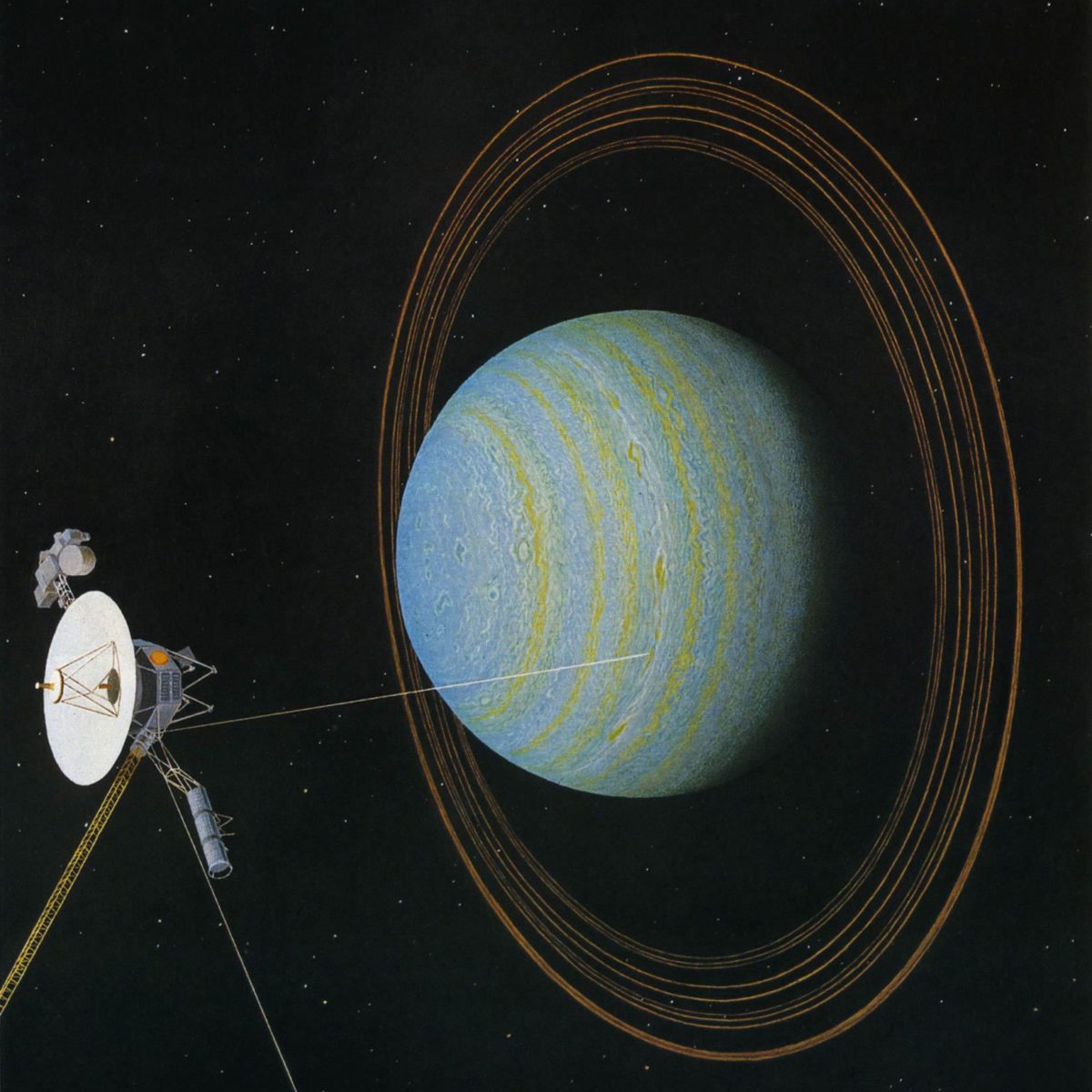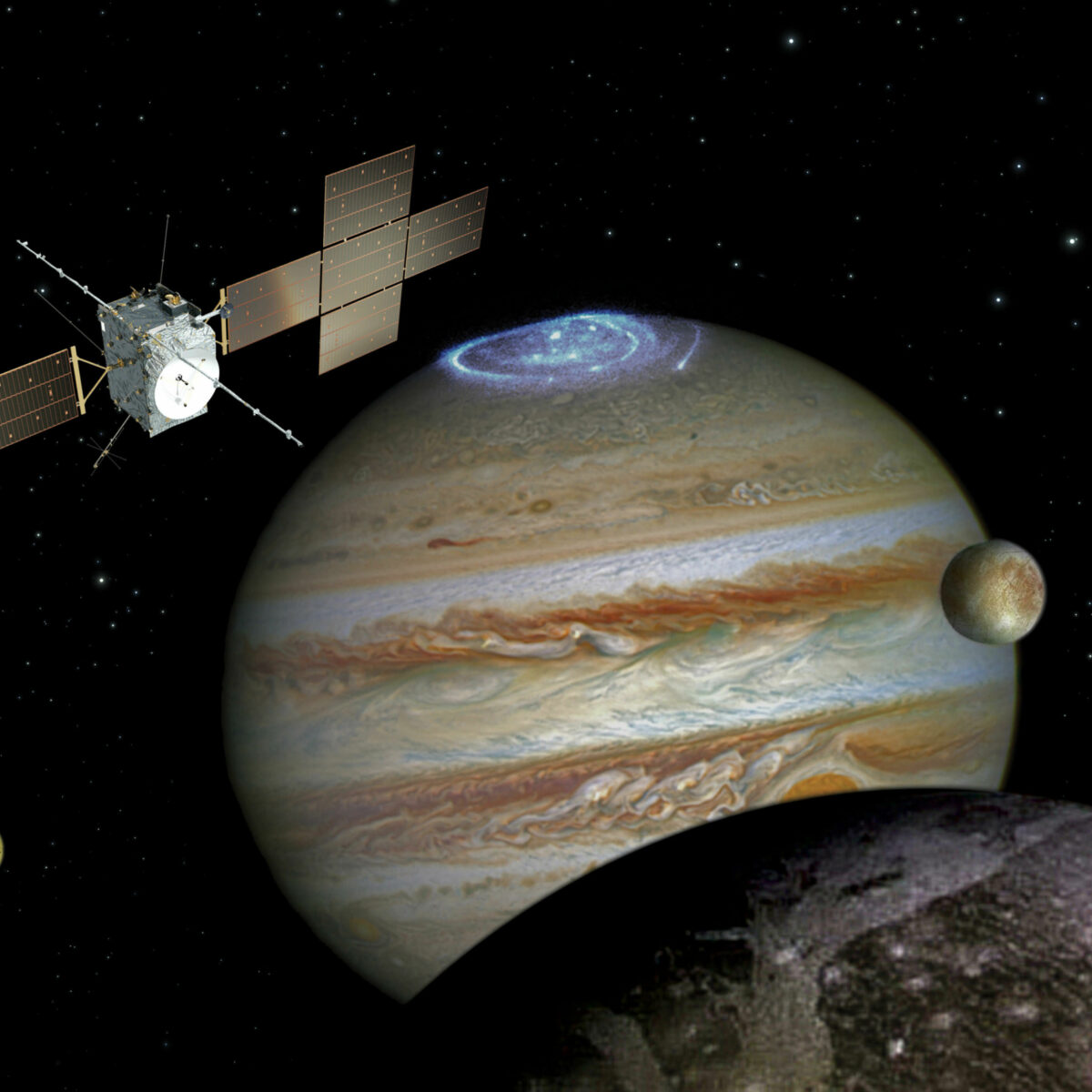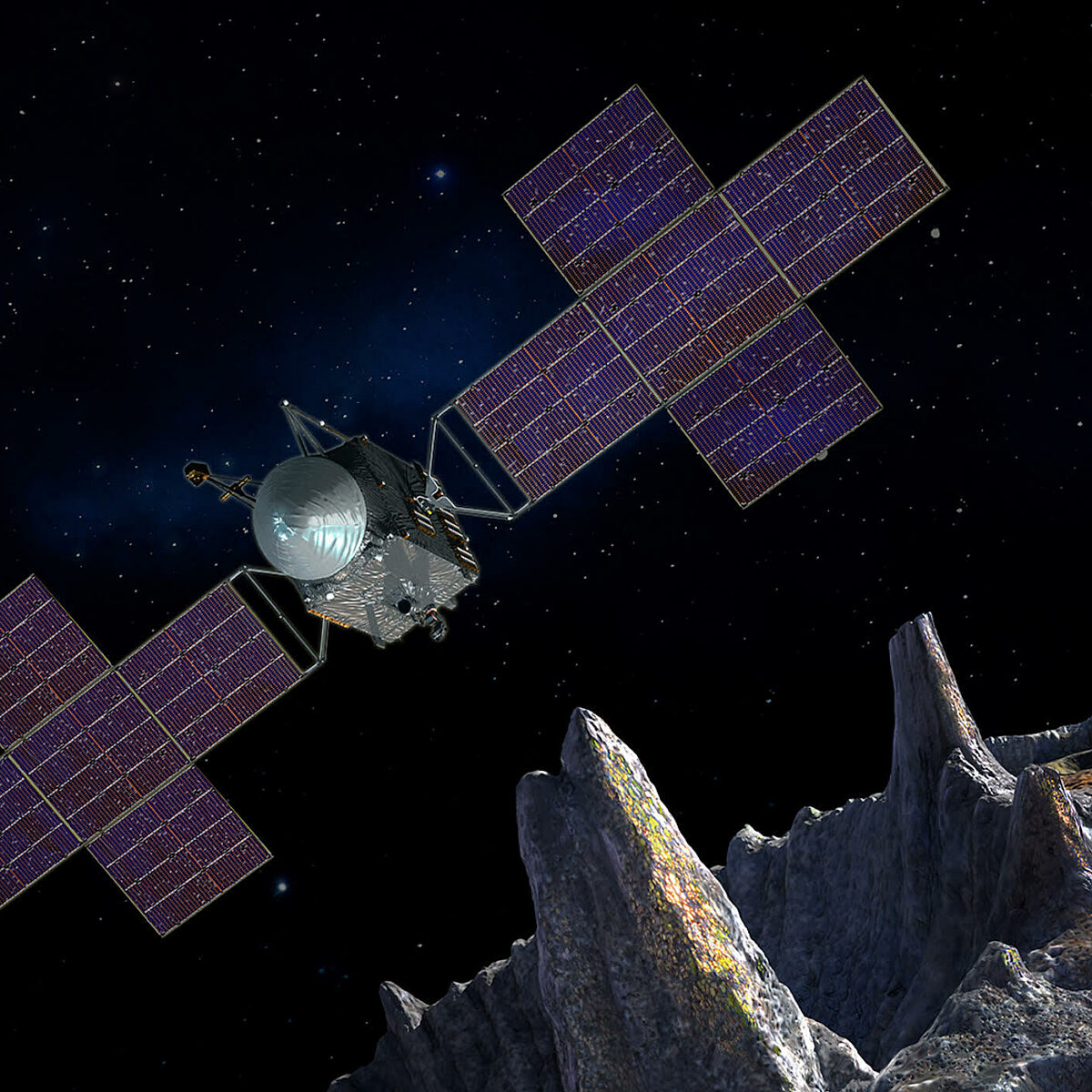Missions Beyond Mars
Exploration of the outer planets requires extreme patience.
Our launch vehicles are not powerful enough to send massive spacecraft directly to the giant planets, so they must take circuitous paths returning to Earth or even traveling inward to Venus for gravity assists to boost momentum enough to send them beyond the asteroid belt. Rendezvousing with asteroids and comets can be even more challenging; they lack sufficient mass to brake fast-moving spacecraft into orbit, so the ships must perform years of orbit adjustment to match position and velocity with the tiniest worlds.
Power is also a problem. Located very far from the Sun, comets, outer planets, and most asteroids receive very little solar energy. Solar arrays must be very large to gather the little sunlight, like those of Rosetta, Dawn, and Juno; or else spacecraft must carry radioisotope thermoelectric generators. The successes of missions like Voyager, Pioneer, Galileo, Cassini-Huygens, and New Horizons require these nuclear power supplies, but Earth has run short of refined plutonium-238, preventing us from planning future missions.
The exceptions to these rules are the missions to near-Earth asteroids, which, by definition, have orbits very similar to our own planet's, permitting them to be explored relatively cheaply and quickly by solar-powered spacecraft like Hayabusa and NEAR. And sometimes, small craft like Deep Impact and Stardust can catch comets as they speed across the inner solar system.
Active missions
OSIRIS-REx, NASA's sample return mission to asteroid Bennu
NASA's OSIRIS-REx mission returned a sample of asteroid Bennu to Earth in 2023.
Hayabusa2, Japan's mission to Ryugu and other asteroids
Hayabusa2 traveled to the asteroid Ryugu, deployed rovers on its surface, and brought samples back to Earth.
Juno, NASA’s Jupiter probe
NASA's Juno spacecraft is searching for answers about Jupiter's origins, as well as how the gas giant has changed over time.
The Voyager missions
Voyager 1 and Voyager 2 launched in 1977 and each made a grand tour of the solar system before heading out of it.
Lucy, exploring Jupiter's Trojan asteroids
NASA's Lucy mission will visit eight Trojan asteroids between 2027 and 2033.
Future missions
Juice, exploring Jupiter’s icy moons
The European Space Agency (ESA) is launching the Juice spacecraft to study Jupiter and its three largest icy moons — Europa, Ganymede, and Callisto.
Europa Clipper, a mission to Jupiter's icy moon
Europa Clipper will help us determine if Jupiter's icy moon Europa could support life.
Psyche, exploring a metal world
The Psyche spacecraft is on its way to be the first ever to visit a metal-rich asteroid.
Dragonfly, NASA's mission to Saturn's moon Titan
NASA's Dragonfly mission is a helicopter drone that will explore Saturn’s largest moon Titan.
Comet Interceptor
Long-period comet flyby mission (ESA)
Selected: June 19, 2019
Launch: 2028, on same rocket as ESA's Ariel
Flyby: not yet knownAll previous comet missions have visited short-period comets, which have traveled into the inner solar system multiple times. Comet Interceptor's goal is to fly past a pristine comet. It will launch to L2 and wait for a target to be discovered. Once a likely target is discovered, Comet Interceptor will travel to intercept it, splitting into 3 spacecraft (a main one and two sub-satellites) a few weeks before the encounter for multi-point observations.
LINKS: Blog posts about Comet Interceptor - Mission website - Mission Twitter
Past missions
Comet 67P/Churyumov-Gerasimenko orbiter and lander (ESA)
Launch: March 2, 2004
Churyumov-Gerasimenko arrival: May 2014
Philae Churyumov-Gerasimenko landing: November 12, 2014
Last signal from Philae: July 8, 2015
Rosetta deorbit: September 30, 2016 July 8, 2015Rosetta's original goal was comet 46P/Wirtanen, but launch delays required a rerouting to 67P/Churyumov-Gerasimenko. The route is long, involving three Earth flybys (in 2005, 2007, and 2009) and one Mars flyby (February 25, 2007). It flew by asteroid 2867 Steins on September 5, 2008 and 21 Lutetia on July 10, 2010. Its long cruise will take it nearly to Jupiter's orbit before it travels inward again to rendezvous with the comet. Since Rosetta is solar-powered, ESA had to place it into a state of deep hibernation for this most distant period of its cruise. Rosetta went to sleep on June 8, 2011 and woke up again on January 20, 2014, four months before its arrival at Churyumov-Gerasimenko. Rosetta entered orbit on August 6, 2014, and dropped its small lander, Philae, to the surface of the comet on November 12, 2014. Philae exhausted its battery on November 15, but brief contact was made with the lander again when Churyumov-Gerasimenko approached perihelion in July 2015. Philae has remained silent since July 8, 2015. The Rosetta orbiter continued its science mission in orbit around Churyumov-Gerasimenko until it was intentionally deorbited on September 30, 2016.
LINKS: Blog posts about Rosetta and Philae - NSSDC (Rosetta) - NSSDC (Philae) - Wikipedia (Rosetta) - Wikipedia (Philae) - ESA
Comet Giacobini-Zinner flyby and distant Halley observer (NASA)
(Formerly known as International Sun-Earth Explorer or ISEE-3)
Launch: August 12, 1978
Flyby: September 11, 1985
Contact lost: September 16, 2014Originally launched to explore Earth's magnetosphere and its interaction with the solar wind, the International Sun-Earth Explorer was renamed the International Cometary Explorer on December 22, 1983. On that date, a lunar gravity assist flyby launched the spacecraft onto a heliocentric orbit ahead of Earth to intercept comet Giacobini-Zinner. It flew through the tail of Giacobini-Zinner on September 11, 1985, and went on to transit between the Sun and Halley's comet in March 1986, becoming the first spacecraft to investigate two comets. There was no contact with ICE after the end of its mission in 1999 until September 18, 2008, when it was successfully re-contacted for a brief status check. On May 29, 2014, two-way communication with the spacecraft was reestablished by the ISEE-3 Reboot Project, and unofficial group with support from the Skycorp company. They successfully fired the thrusters on July 2, 2014, the first time they had fired since 1987. However, later firings of the thrusters failed, and contact with the spacecraft was lost on September 16, 2014. It is unknown whether contact can be reestablished as the probe's exact orbit is uncertain.
LINKS: Blog posts about ICE - NSSDC - Wikipedia - GSFC
Failed asteroid flyby (JAXA/ISAS)
Launch: December 3, 2014
Launched with Hayabusa2, the PRoximate Object Close flYby with Optical Navigation (PROCYON) mission was a 50 kg-class microsatellite with two goals: Testing a microsatellite bus system for deep space exploration, and performing a close flyby observation (within 50 km) of an asteroid. The spacecraft entered its planned initial Earth-resonant orbit on December 4, 2014, where it commenced its initial operation phase. The mission returned to Earth near the end of 2015 with its solar electric propulsion system, where its ion engine failed to perform a deep space maneuver to change its trajectory toward its target asteroid 2000 DP107.
LINKS: Blog posts about PROCYON - NSSDC - ESA eoPortal Directory
Asteroid 4 Vesta and dwarf planet 1 Ceres orbiter (NASA)
Launch: September 27, 2007
Vesta arrival: July 16, 2011
Ceres arrival: April 2015
End of mission: October 31, 2018After flying past Mars on February 4, 2009, Dawn crept up on asteroid 4 Vesta, becoming the first orbiter of a main-belt asteroid. After surveying the asteroid from many altitudes, Dawn departed Vesta in the summer of 2012, embarking on a journey that ended with orbit insertion at 1 Ceres in April 2015. The mission observed Ceres until exhausting its fuel, and remains in a stable orbit.
LINKS: Blog posts about Dawn - NSSDC - Wikipedia - JPL - UnmannedSpaceflight
Flyby and impact into comet 9P/Tempel 1 (NASA)
Launch: January 12, 2005
Tempel 1 impact and flyby: July 4, 2005
Hartley 2 flyby: November 4, 2010
Last heard from: August 8, 2013One day prior to its flyby of Tempel 1, Deep Impact released a 364-kilogram copper impactor onto a collision course with the comet. The impactor captured images all the way down to its 10.2 kilometer-per-second impact with Tempel 1. The flyby spacecraft captured amazing views of the impact from a safe distance as every large telescope on Earth was also pointed at the comet. Since the end of its primary mission, Deep Impact's blurred camera has been employed to study exoplanets (a project called the EPOXI mission), and the spacecraft has encountered a second comet, 103P/Hartley 2. The spacecraft is low on fuel but otherwise still functional and now being tested for future use as a deep-space astronomical observatory. It was then targeted for a 2020 flyby of asteroid (163249) 2002GT, but contact was lost after August 8, 2013.
LINKS: Blog posts about Deep Impact - NSSDC (EPOXI) - NSSDC (Impactor) - Wikipedia - UMD
Orbiter and sample return from asteroid Itokawa (1998 SF36) (ISAS/JAXA)
Launch: May 9, 2003
Itokawa arrival: September 2005
Earth sample return: June 13, 2010Hayabusa's mission to and from asteroid Itokawa was one of the most thrilling adventures in modern space exploration, marked by numerous near-mission-ending disasters saved by the ingenuity of mission engineers, and culminating in the fiery death of the parent spacecraft on the night of the return of its sample capsule — a story much too long for this space (and dramatic enough to be the subject of three feature-length films in Japan). Hayabusa rendezvoused with and touched down on a very small asteroid. It deployed a hopper named "Minerva" on November 12, 2005, but the hopper missed the asteroid. It did successfully drop a target marker containing 880,000 names to the surface, and then followed the marker down for two landing attempts. Upon the successful return of the sample capsule, a very small amount of asteroid dust was found inside, plenty for analysis by labs trained on the Stardust samples.
LINKS: Blog posts about Hayabusa - NSSDC - Wikipedia - JAXA
Comet Nucleus Tour (CONTOUR)
Failed multi-comet flyby (NASA)
Launch: July 3, 2002
CONTOUR was lost August 15, 2002, when the spacecraft failed to contact Earth shortly after a scheduled firing of its main rocket motor. Investigation revealed that the spacecraft broke apart toward the end of the rocket motor firing. The spacecraft had been scheduled to fly by at least three comets: comet 2P/Encke in 2003, continuing with 29P/Schwassmann-Wachmann in 2006, and 6P/d'Arrest in 2008.
LINKS: NSSDC - Wikipedia - NASA
Flyby and coma sample return from comet P/Wild 2 (NASA)
Launch: February 7, 1999
Annefrank flyby: October 31, 2002
Wild 2 flyby: January 2, 2004
Sample return: January 15, 2006
Tempel 1 flyby: February 15, 2011
Propellant exhausted: March 24, 2011Stardust flew past Earth on November 14, 2000, and then asteroid 5535 Annefrank. When Stardust flew by Wild 2, it collected samples of dust and volatiles from the comet's coma as well as images and other data. Other objectives of the mission included collecting samples of interstellar dust grains, imaging the comet nucleus, and conducting preliminary analysis of the composition of the cometary dust particles. It returned the samples to Earth on January 15, 2006. The aerogel collector plates proved to be full of cometary material, surpassing the science team's expectations. Following another Earth flyby on January 14, 2009, Stardust was sent onward to comet 9P/Tempel 1, which had been the target of the Deep Impact mission. With nearly no fuel left onboard, Stardust was commanded to burn the rest of it to depletion before powering down for good.
LINKS: Blog posts about Stardust - NSSDC (Stardust/NExT) - NSSDC (Sample Return Capsule) - Wikipedia - JPL
Flybys of asteroid 9969 Braille and comet 19P/Borrelly (NASA)
Launch: October 24, 1998
Braille flyby: July 28, 1999
Borrelly flyby: September 22, 2001
Engine shut down: December 18, 2001Deep Space 1 was a demonstration probe designed to test new technologies such as ion propulsion. The spacecraft flew by asteroid 9969 Braille, which was named through a Planetary Society-run contest, within 15 kilometers of the asteroid's surface. With all systems still operating at the end of its primary mission in September 1999, engineers decided to extend the mission and attempt a flyby of comet 19P/Borrelly. By the time Deep Space 1 reached Borrelly, it had lasted three times longer than expected. It flew within 2,200 kilometers of the comet, providing the most detailed images of a comet's nucleus yet seen. With its fuel almost gone and its instruments in varying states of disrepair, communication with the spacecraft was terminated in December 2001. However, the spacecraft could, in theory, be re-contacted and returned to service, as ICE was.
Cassini, the mission that revealed Saturn
NASA’s Cassini mission orbited Saturn from 2004 to 2017, circling the planet 294 times and teaching us almost everything we know about our ringed neighbor
Asteroid 433 Eros orbiter (eventually used as a lander!) (NASA)
Launch: February 17, 1996
Eros arrival: February 14, 2000
Eros landing: February 12, 2001
End of mission: February 28, 2001During its yearlong mission, NEAR gathered 10 times more data than originally planned. On February 12, 2001, with its fuel and funding nearly depleted, mission planners tried the unprecedented maneuver of landing the orbiter on Eros. With fragile solar panels and protruding antennae, NEAR was never intended to be a lander. However, controllers successfully brought the spacecraft to a gentle 1.9 meter-per-second touchdown onto the rocky surface, taking 69 images during the final descent. The spacecraft continued to function even after it landed. NEAR was officially shut down on February 28, 2001.
Successful Solar polar orbiter (NASA)
Launch: October 6, 1990
Jupiter flyby: February 8, 1992
Mission end: June 30, 2009The primary mission of Ulysses was to study the north and south pole of the Sun. However, getting to those solar poles required the spacecraft to perform some interplanetary gymnastics. The spacecraft first went to Jupiter, where the strong Jovian gravity helped redirect the spacecraft, placing it on its proper course. As Ulysses flew by the planet, instruments onboard the spacecraft studied Jupiter's strong magnetic field and radiation levels. The mission was long and productive, ending only in 2008 after the X-band transmitter failed and the fuel had nearly frozen.
LINKS: Blog posts about Ulysses - NSSDC - Wikipedia - JPL
Jupiter orbiter, with flybys of asteroids 951 Gaspra and 243 Ida/Dactyl (NASA)
Launch: October 18, 1989
Gaspra flyby: October 29, 1991
Ida/Dactyl flyby: August 28, 1993
Witnessed Shoemaker-Levy crash: July 1994
Jupiter probe descent: December 7, 1995
Jupiter orbit insertion: December 8, 1995
Plunge into Jupiter: September 22, 2003After a long and troubled development process culminating with a launch from Space Shuttle Atlantis, Galileo traveled past Venus once (on February 10, 1990) and Earth twice (on December 8, 1992 and August 28, 1993). But it had suffered a crippling malfunction early in its mission when its high-gain antenna failed to open. Still, Galileo accomplished the first ever asteroid flybys as it traveled through the main belt on its way to Jupiter. It passed within 1,600 kilometers of Gaspra and 2,400 kilometers of Ida. Galileo made the surprising discovery that Ida has a tiny satellite, which was later named Dactyl. As Galileo approached its insertion into Jupiter orbit, it happened to be the right place in the right time to observe comet Shoemaker-Levy 9 break up and crash into Jupiter. Galileo was the only observatory that had a direct view of the impact, which happened on Jupiter’s night side; Earth-based telescopes had to wait until Jupiter’s rotation brought the impact zone into view hours later. Galileo was the first spacecraft to deploy a probe into an outer planet’s atmosphere. When the Jupiter Probe plunged into the Jovian clouds, it sent back information about the temperature, wind speeds, and pressure as it descended. It finally succumbed to the incredible pressure (24 times Earth's pressure at sea level) one hour after it began its descent. Galileo was also the first spacecraft to dwell in a giant planet's magnetosphere long enough to identify its global structure and investigate the dynamics of Jupiter's magnetic field. It revealed that Jupiter's ring system is formed by dust kicked up as interplanetary meteoroids smash into the planet's four small inner moons and that the planet's outermost ring is actually two rings, one embedded within the other. The spacecraft’s mission was extended three times in order to study the Galilean satellites Io, Europa, Ganymede, and Callisto. Galileo made many discoveries about these moons: Io's extensive volcanic activity is 100 times greater than that found on Earth; Europa harbors a salty ocean up to 100 kilometers (62 miles) underneath its frozen surface, containing about twice as much water as all the Earth's oceans; Callisto and Ganymede may also feature a liquid-saltwater layer; and Ganymede has an iron core, like Earth, and a magnetic field, making this moon the first satellite known to possess a magnetic field. In order to avoid any possibility of the spacecraft contaminating Europa’s salty ocean with material brought from Earth, the spacecraft was deliberately destroyed by sending it onto a collision course with Jupiter.
LINKS: Blog posts about Galileo - NSSDC - Wikipedia - JPL
Comets 1P/Halley and 26P/Grigg-Skjellerup flyby (ESA)
Launch: July 2, 1985
Halley flyby: March 13, 1986
Grigg-Skjellerup flyby: July 10, 1992
End of mission: July 23, 1992Giotto flew by Halley at a distance 596 kilometers. All experiments performed well and returned a wealth of new scientific results, of which perhaps the most important was the clear identification of the cometary nucleus. During an extended mission, the spacecraft successfully encountered comet Grigg-Skjellerup at a distance of 200 kilometers.
LINKS: Blog posts about Giotto - NSSDC - Wikipedia - ESA
Comet 1P/Halley flyby (ISAS)
Launch: March 18, 1985
Flyby: March 8, 1986
Fuel depleted: February 22, 1991Suisei (which translates to ‘Comet') was identical to Sakigake apart from its payload: an ultraviolet (UV) imaging system and a solar wind instrument. Suisei began UV observations in November 1985, generating up to 6 images per day. The spacecraft encountered Comet 1P/Halley at a distance of 151,000 kilometers. ISAS had decided during 1987 to guide Suisei to a November 24, 1998 encounter with 21P/Giacobini-Zinner, but due to depletion of the hydrazine, this, as well as plans to fly within several million kilometers of comet 55P/Tempel-Tuttle on February 28, 1998, were canceled.
Comet 1P/Halley flyby (ISAS)
Launch: January 8, 1985
Flyby: March 11, 1986
Contact lost: November 15, 1995Sakigake (which translates to 'Pioneer') was a prototype spacecraft launched by the Japanese space agency ISAS. It successfully flew within 7 million kilometers of Halley's comet. The spacecraft was equipped with 3 instruments to measure plasma wave spectra, solar wind ions, and interplanetary magnetic fields. An extended mission was planned, including flybys of comet 45P/Honda-Mrkos-Pajdusakova in 1996 and comet 21P/Giacobini-Zinner in 1998. Unfortunately, controllers lost contact with the spacecraft.
LINKS: NSSDC - Wikipedia - JAXA
Vega 1 and Vega 2
Comet 1P/Halley flybys (Soviet Academy of Sciences)
Launch: December 15 and 21, 1984
Flyby: March 6 and 9, 1986The identical Vega 1 and Vega 2 combined Venus swingbys with flybys of comet 1P/Halley. It is estimated that Vega 1 flew by at a distance of 10,000 kilometers (6,000 miles), and Vega 2 at 3,000 kilometers (1,800 miles).
LINKS: Blog posts about Vega - NSSDC (Vega 1) - NSSDC (Vega 2) - Wikipedia (Vega 1) - Wikipedia (Vega 2) - IKI
Pioneer 10 and 11, outer solar system explorers
NASA’s Pioneer 10 and 11 are twin probes that helped illuminate the outer stretches of our solar neighborhood.


 Explore Worlds
Explore Worlds Find Life
Find Life Defend Earth
Defend Earth


